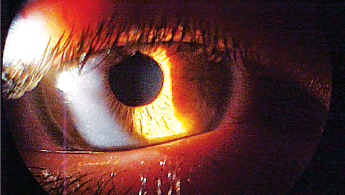 History
History
A 32-year-old black female presented to the office following referral from the emergency department. The attending ER physician diagnosed the patient with a corneal plaque O.D. and prescribed both prednisolone acetate drops and sulfacetamide 10% drops q.i.d. for that eye. Her systemic history was noncontributory, and her ocular history was significant for extended soft contact lens wear. She reported no sensitivities to medications.

This 32-year-old patient with an ocular history significant for extended soft contact lens wear presented to the office following referral from the emergency department.
Diagnostic Data
Her best-corrected visual acuity measured 20/30 O.D. and 20/20 O.S. at distance and near. External examination was normal, with no evidence of a relative afferent pupillary defect.
Intraocular pressure was 14mm Hg O.U. The posterior pole and peripheral retinal examination were normal O.U. The pertinent anterior segment findings are illustrated in the photograph.
Your Diagnosis
How would you approach this case? Does this patient require any additional tests? What is your diagnosis? How would you manage this patient? What's the likely prognosis?
Discussion
Additional tests might include NaFl staining, corneal sensitivity testing and anterior chamber examination to rule out the presence of cells and flare.
The diagnosis in this case is contact lens-associated acute red eye (also known as contact lens overwear syndrome or immobile lens syndrome). This case is interesting because the peripheral infiltrate formed a 360-degree ring in the precise area that the contact lens was inducing corneal anoxia.
Rigid and soft contact lens overwear produces contact lens-associated keratopathy (CLAK), which demonstrates a coarse, central pattern of staining. When new contact lenses become coated with mucoproteinaceous deposits because of increased wear, the lenses lose oxygen permeability, move less, flush less debris, and become susceptible to the adherence of bacteria.1 Chronic epithelial exposure to bacteria allows organisms to adhere to the lens, replicate and incite an inflammatory corneal edema.2 In extreme cases, this cascade might cause ulcerative keratitis.1,2 Additionally, the corneal stroma typically is invaded by infiltrating polymorphonuclear leukocytes from limbal blood vessels, exudation from inflamed iris blood vessels and surface exudation from inflamed limbal blood vessels.1-4
In recent years, researchers have identified that the amount of protein observed or measured on a contact lens as well as the severity of upper conjunctival papillae, upper lid conjunctival hyperemia and limbal congestion might reveal patterns of contact lens overwear.5
We instructed our patient to suspend contact lens wear indefinitely. Then, we treated her with a moderate cycloplegic in the office and medicated her with a topical fluorinated quinolone antibiotic q2h, topical Acular (ketorolac tromethamine,Allergan) q12h and 600mg Motrin (ibuprofen, Pfizer) p.o. t.i.d. with meals. The next day, we titrated the antibiotic to q3h. On the third day, we titrated the antibiotic to q.i.d., instructed her to discontinue the topical Acular and Motrin, and added topical Lotomax (loteprednol, Bausch & Lomb) q.i.d. and NaCl ointment h.s.
Her condition resolved completely in approximately 10 days. We refit her with soft contact lenses and further educated her on proper contact lens care.
1. Yamane SJ. Are hard lenses superior to soft? The advantages of soft lenses.
Cornea. 1990;9 Suppl 1:S12-4; discussion S15.
2. Binder PS. The physiologic effects of extended wear soft contact lenses.
Ophthalmology. 1980 Aug;87(8):745-9.
3. Bennet ES, Davis LJ. Noninfectious Corneal Staining. In: Silbert JA. Anterior Segment Complications of Contact Lens Wear.
4. Dumbleton K. Adverse events with silicone hydrogel continuous wear. Cont Lens Anterior Eye. 2002 Sep;25(3):137-46.

